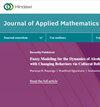Comparison of Linear and Nonlinear Programming Techniques for Animal Diet
IF 1.3
Q2 MATHEMATICS, APPLIED
引用次数: 29
Abstract
Linear programming techniques have been extensively used for animal diet formulation for more than last fifty years. To overcome the drawback of linear approximation of objective function for diet formulation, a mathematical model based on nonlinear programming technique is proposed to measure animal performance in terms of milk yield and weight gain. At the second step, it compares the result of proposed program with that of linear programming model. Result of proposed model gives better results using nonlinear programming. Thus the study is an attempt to develop a nonlinear programming model for optimal planning and best use of nutrient ingredients. Research on nutrition is under process for more than hundred years. Diet formulation is a process by which different ingredients are combined to provide necessary nutrition to animals at different stages of production. A diet should supply all essential nutrients and energy to maintain vital physiological functions of growth, reproduction and health of animals. Diet should be highly digestible and should have very less adverse environmental effect. A number of methods have been defined for the formulation of animal diet; square method, two by two matrix methods, simultaneous equation method, trial and error method and linear programming method to formulate least cost diet. Linear programming is widely used for this purpose. Diet formulated by linear programming is based on assumption of linearity between animal yield and nutrient ingredients included in the diet. To overcome the assumption of linearity and to include complexity of different nutrient ingredients, a nonlinear model is proposed in this paper to maximize milk yield. This concept of non-linear programming may be used to maximize the weight gain of the animal or animal yields approximately. A combination spreadsheet is represented for ration formulation using linear programming (VandeHaar M. J., Black J. R., 1991). Chance-constrained programming is used to formulate commercial feeds for animals (William B. Roush, Robert H. Stock, Terri L. Cravener and Thomas H. D'Alfonso, 1994). Genetic algorithms are applied for the cost动物饲料线性与非线性规划技术的比较
近50多年来,线性规划技术在动物饲料配方中得到了广泛应用。为克服日粮配方中目标函数线性逼近的缺点,提出了一种基于非线性规划技术的动物产奶量和增重数学模型。第二步,将所提方案的结果与线性规划模型的结果进行比较。该模型采用非线性规划方法得到了较好的结果。因此,本研究试图建立一种非线性规划模型,以实现营养成分的最优规划和最佳利用。对营养学的研究已经进行了一百多年。饲料配方是将不同的成分混合在一起,在不同的生产阶段为动物提供必要的营养的过程。饲粮应提供所有必需的营养和能量,以维持动物生长、繁殖和健康的重要生理功能。饮食应该是高度可消化的,应该对环境的不利影响很小。已经确定了许多动物饲料配方的方法;采用平方法、二乘二矩阵法、联立方程法、试错法和线性规划法制定最小成本饮食。线性规划被广泛用于此目的。通过线性规划制定的日粮是基于动物产量与日粮中营养成分之间的线性关系的假设。为了克服线性假设和考虑不同营养成分的复杂性,本文提出了一个非线性模型,以最大限度地提高产奶量。这种非线性规划的概念可以用来最大化动物的增重或动物产量的近似。使用线性规划表示定量公式的组合电子表格(VandeHaar M. J., Black J. R., 1991)。机会约束规划用于制定动物的商业饲料(William B. Roush, Robert H. Stock, Terri L. craver和Thomas H. D'Alfonso, 1994)。采用遗传算法求解成本
本文章由计算机程序翻译,如有差异,请以英文原文为准。
求助全文
约1分钟内获得全文
求助全文
来源期刊

Journal of Applied Mathematics
MATHEMATICS, APPLIED-
CiteScore
2.70
自引率
0.00%
发文量
58
审稿时长
3.2 months
期刊介绍:
Journal of Applied Mathematics is a refereed journal devoted to the publication of original research papers and review articles in all areas of applied, computational, and industrial mathematics.
 求助内容:
求助内容: 应助结果提醒方式:
应助结果提醒方式:


